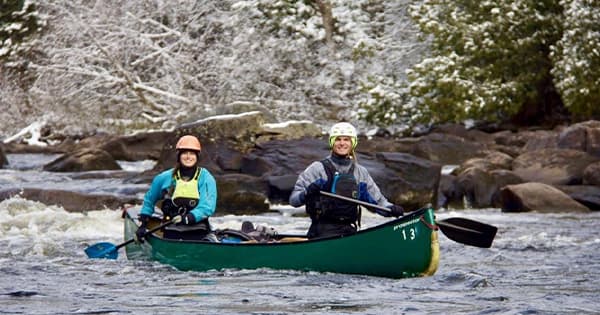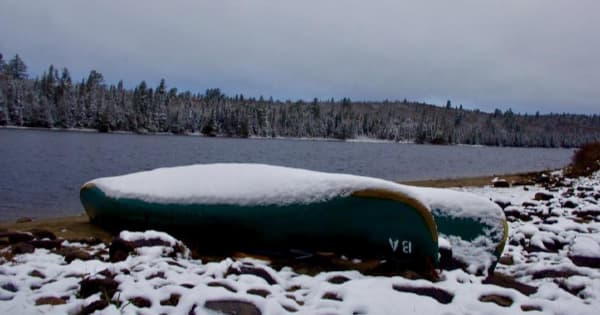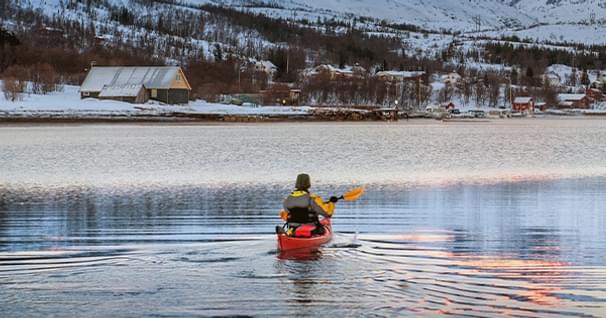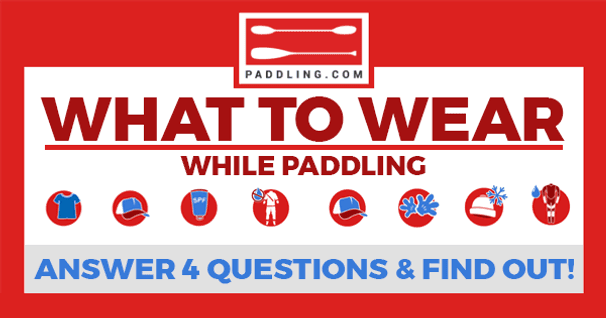Stop the Screaming Barfies: Extend your Paddling Season Into the Fall and Winter
You wake up to a bluebird day in March, the sun is piercing through the trees and a blanket of fresh snow sparkles in the light. By mid-morning, you hear the drops of melting snow pit-pattering on your tin roof. You know the snow will be too sticky to ski, and for the first time you see a clear path to your canoe that has been buried for months. The thought of a first paddle immediately pops into your brain, so you send a message to your buddy who is always keen to get on the water. A near instant “Heck ya!” is their response, and you skip outside to load your boat.
Welcome to the shoulder seasons: late fall when the leaves are on the ground, but not yet covered in snow, and early spring when these same leaves start to make an appearance again. It depends on who you talk to, but only the bravest, and/or odd paddlers consider the shoulder seasons as an extension of the regular paddling season. Cold water is a key deterrent for most paddlers, and those who have experienced the screaming barfies, know exactly how agonizing they can be.

What are the Screaming Barfies?
To loosely define the term screaming barfies, your fingers and toes go so numb from cold, that the rewarming process is so painful you feel like screaming and puking. Though the term screaming barfies was coined in the mountaineering world, paddlers alike are known to experience them during the shoulder seasons. This dreaded period usually happens after long exposure to cold when you stop paddling - i.e.: you finally release the grip on your paddle, or you unfold yourself from your boat. You quickly realize how numb your extremities are and you try to shake out your limbs to regain some feeling. Gradually the tingling starts and quickly the feeling of stabbing pins/needles sets in - hence the need to scream and barf.
There are legends of paddlers driving to the nearest grocery stores to defrost their frozen drysuit zippers after paddling. Other tales suggest attempts made to surf floating ice chunks in rapids. Late fall and early spring are the perfect times to explore your local waterways. Water levels are typically higher, and the summer crowds have dispersed for the most part. Don’t let the threat of screaming barfies deter you from paddling in the shoulder seasons. With some intentional planning and gear, you too will be excited to paddle year-round.
Dress for the water, NOT the weather
As tempting as it is to dress for the air temperature, a lack of preparedness for cold water can lead to avoidable risk. Though air temperatures may remain in the mid-teens throughout the fall, water temperatures drop much quicker and take longer to rewarm in the spring. It is the awkward time of year when you sweat through your thermal layers as you portage, but you also see ice forming on the shorelines. If it is cold enough for ice to form overnight, water temperatures should be considered as winter conditions.
Dressing in appropriate thermal protection is the best way to prepare for cold water and to minimize the risk of immersion. A dry suit is the ultimate gear item to extend your paddling season. Although neoprene keeps you warm when it is wet, wetsuits are difficult to layer under and you still get fully wet. As the name suggests, you stay completely dry in a dry suit and you can add additional layers under it, which also stay dry. Instead of wearing bulky items under your dry suit, go for thin layers of polypro, fleece, or wool that can easily be interchanged or added as needed. Don’t forget the threat of screaming barfies, and wear neoprene gloves and socks when you paddle.
If something happens, can you respond?
You can assume a higher degree of risk when you are exposing yourself to winter conditions. When you ask yourself the question, “Will I be okay if I end up in the water?” you should always be able to answer with a confident “YES!” It is important to consider the 1-10-1 principle, which offers a simplified explanation of how our bodies react to cold water. After falling into cold water, you have 1 minute to control your breathing, 10 minutes of purposeful movement in which you could help with your rescue, and a 1-hour window before hypothermia sets in and you become unconscious.
You may have the goal of paddling every month of the year but paddling during the shoulder seasons may look different than when you are paddling in the summer season. Details like group size and skill, and river classification should be carefully considered when deciding where to paddle in winter conditions. Do not assume that the local emergency services will be able to respond to water calls. Most rural fire departments and search and rescue teams are volunteer operated, and few are trained in ice and/or swift water rescue.
When in doubt, chill out and keep the open side up.

A teacher, whitewater canoe guide, and volunteer firefighter, Allyson Saunders lives in the Madawaska Valley in Ontario with her exceptionally perfect dog, Honey. Nature inspired, Allyson can be found on a river, in her garden, on a ski trail or with a paintbrush or a cup of coffee in hand.
Related Articles
Gliding through glass on a crisp, winter morning can be an experience like no other. Whether we’re…
Wondering what to wear when going paddling? Answer 4 quick questions and instantly learn what you need…
Honey the River Dog. Photo by Allyson Saunders We are all guilty of scrolling mindlessly through our…
The word portage loosely translates to “carrying heavy sh*t” and it is a time when most of us grit our…



